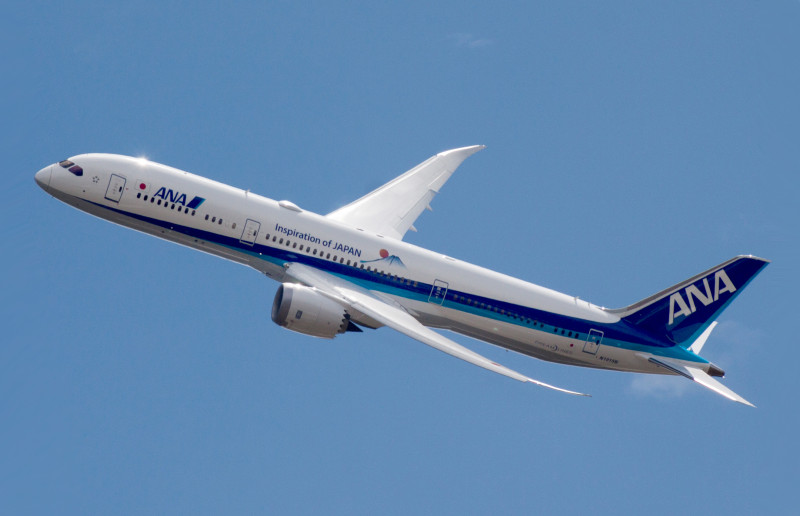The Boeing 787 Dreamliner is an American wide-body airliner developed by Boeing Commercial Airplanes. Announced on January 29, 2003, as the 7E7, it prioritized efficiency after the Sonic Cruiser project was dropped. The program launched on April 26, 2004, with an order from All Nippon Airways (ANA), targeting a 2008 introduction. A prototype was rolled out on July 8, 2007, but the aircraft experienced multiple delays until its maiden flight on December 15, 2009. Type certification was received in August 2011, and the first 787-8 was delivered in September 2011, entering commercial service on October 26, 2011, with ANA.
1979: FAA grounds Boeing 787s on January 16, 2013: First airliner grounding since 1979
On January 16, 2013, the FAA issued an emergency airworthiness directive ordering all American-based airlines to ground their Boeing 787s. This marked the first time the FAA had grounded an airliner type since 1979.
1984: First CFRP primary structure in Boeing 737 Classic
In 1984, the first CFRP primary structure in a Boeing commercial aircraft was put into service on the horizontal tail of the Boeing 737 Classic.
December 20, 2002: Sonic Cruiser Officially Canceled
On December 20, 2002, the Sonic Cruiser project was officially canceled due to a disrupted global airline market and increased petroleum prices after the 9/11 attacks.
January 29, 2003: Boeing announces the 7E7
On January 29, 2003, Boeing announced the conventional 7E7 project, which focused largely on efficiency, after dropping its unconventional Sonic Cruiser project.
July 2003: 7E7 Public Naming Competition
In July 2003, a public naming competition was held for the 7E7, with Dreamliner as the winning title out of 500,000 votes cast online.
December 16, 2003: 787 Assembly in Everett, Washington
On December 16, 2003, Boeing announced that the 787 would be assembled in its factory in Everett, Washington, using a method of joining completed subassemblies and integrating systems.
April 26, 2004: 787 program launch
On April 26, 2004, the 787 program was launched with an order for 50 aircraft from All Nippon Airways (ANA), targeting a 2008 introduction.
2004: Carbon Fiber Production Contract
In 2004, Japanese manufacturer Toray Industries and Boeing agreed to a carbon fiber production contract.
2005: Customer Orders Reach 237 Aircraft
By 2005, customer-announced orders and commitments for the 787 reached 237 aircraft.
2005: James McNerney becomes Boeing's Chairman and CEO
In 2005, James McNerney became Boeing's Chairman and CEO.
2005: 787 battery contract signed in 2005
In 2005, the Boeing 787 battery contract was signed. At the time, lithium cobalt oxide (LiCoO2) batteries were the only type of lithium aerospace battery available.
April 26, 2006: Production Agreement Between Toray Industries and Boeing
On April 26, 2006, Japanese manufacturer Toray Industries and Boeing signed a production agreement involving US$6 billion worth of carbon fiber, extending a 2004 contract.
2006: First 787s Overweight
In late 2006, it was stated that the first six 787s were overweight, with the first aircraft being 5,000 lb (2,300 kg) heavier than specified.
May 2007: Final Assembly Begins
In May 2007, the final assembly on the first 787 began at Everett.
July 8, 2007: 787 Prototype Rollout
On July 8, 2007, a prototype 787 without major operating systems was rolled out.
September 2007: First Delay Announced
In September 2007, Boeing announced a three-month delay, blaming a shortage of fasteners as well as incomplete software.
October 10, 2007: Second Delay Announced
On October 10, 2007, a second three-month delay to the first flight and a six-month delay to first deliveries were announced due to supply chain problems, a lack of documentation from overseas suppliers, and flight guidance software delays.
2007: 787-8 List Price Increase
By 2007, the list price of the 787-8 variant had increased to US$157–167 million, exceeding US$200 million by the time the aircraft received type certification.
2007: FAA approves 787 battery in 2007
In 2007, the FAA approved a Boeing 787 battery with nine special conditions. The approved battery was made by Rose Electronics using Kokam cells, while the batteries installed in the Boeing 787 are made by Yuasa.
January 2008: FAA Concerns Reported Regarding Possible Passenger Access to the 787's Computer Networks
In January 2008, concerns were raised by the FAA regarding the possibility of passengers accessing the 787's computer networks. Boeing responded by stating that protective hardware and software solutions were in place, including air gaps and firewalls, to prevent data transfer from the passenger internet system to the maintenance or navigation systems.
January 16, 2008: Third Delay Announced
On January 16, 2008, Boeing announced a third three-month delay to the first flight of the 787, citing insufficient progress on traveled work.
March 28, 2008: Boeing Plans to Buy Vought Aircraft Industries' Interest
On March 28, 2008, to gain more control over the supply chain, Boeing announced plans to buy Vought Aircraft Industries' interest in Global Aeronautica; a later agreement was also made to buy Vought's factory in North Charleston.
April 9, 2008: Fourth Delay Announced
On April 9, 2008, a fourth delay was announced, shifting the maiden flight to the fourth quarter of 2008, and delaying initial deliveries by around 15 months to the third quarter of 2009.
November 4, 2008: Fifth Delay Announced
On November 4, 2008, a fifth delay was announced due to incorrect fastener installation and the Boeing machinists strike, stating that the first test flight would not occur in the fourth quarter of 2008.
December 2008: First Flight Delayed
After assessing the program schedule with suppliers, in December 2008, Boeing stated that the first flight was delayed until the second quarter of 2009.
December 15, 2009: 787 Maiden Flight
On December 15, 2009, after multiple delays, the 787 experienced its maiden flight.
2009: Construction of Two Flight-Test 787s
Two flight-test 787s were built in 2009 and later written off as research and development expense by Boeing.
2010: Consideration of In-House Tail Construction
In 2010, Boeing considered in-house construction of the 787-9 tail, as the tail of the 787-8 is made by Alenia.
August 2011: 787 Type Certification
In August 2011, the 787 received type certification.
September 2011: First 787-8 Delivery
In September 2011, the first 787-8 was delivered.
September 2011: First official delivery of the 787 to All Nippon Airways in September 2011
In September 2011, the first Boeing 787 was officially delivered to its launch customer, All Nippon Airways.
October 26, 2011: 787 Enters Commercial Service
On October 26, 2011, the first 787-8 entered commercial service with ANA.
2011: Boeing initiates the ecoDemonstrator program in 2011
In 2011, Boeing initiated the ecoDemonstrator program. This program aims to develop technology and techniques to reduce the environmental effects of aviation, utilizing a different airframe each year for testing in collaboration with various partner organizations.
2011: FAA Investigates Quality-Control Lapses Dating Back to 787 Introduction
The month after August 2020, Boeing admitted that "nonconforming" sections of the rear fuselage did not meet engineering standards, and the FAA was investigating quality-control lapses dating back to the introduction of the 787 in 2011.
October 5, 2012: Air India Takes Possession of Dreamliner
On October 5, 2012, Air India became the first carrier to take possession of a Dreamliner manufactured in the Charleston, South Carolina Boeing plant, which was the first Boeing Dreamliner manufactured outside of Washington state.
January 7, 2013: Boston Battery Fire
On January 7, 2013, there was a battery fire in Boston, as mentioned in the NTSB report of March 7, 2013. Firefighters tried to extinguish the fire, but the smoke and flame persisted.
January 13, 2013: Further fuel leak at Narita International Airport on January 13, 2013
On January 13, 2013, another fuel leak was reported at Narita International Airport outside Tokyo. The aircraft reportedly was the same one that had a fuel leak on January 8, raising further concerns and prompting Japan's transport ministry to launch an investigation.
January 2013: FAA Grounds 787s
In January 2013, the U.S. FAA grounded all 787s due to problems caused by lithium-ion batteries.
January 2013: Grounding of the 787 Fleet Due to Lithium Battery Fires
Starting in January 2013, the 787 fleet was grounded due to multiple lithium battery fires, leading to a regulatory investigation of the battery systems.
January 16, 2013: ANA Flight 692 diverts due to battery problem on January 16, 2013
On January 16, 2013, All Nippon Airways (ANA) Flight 692 diverted to Takamatsu after a battery problem warning and burning smell. Passengers evacuated via slides, with minor injuries. A similar incident at Boston's Logan International Airport led the FAA to ground all Boeing 787s. ANA and JAL voluntarily grounded their fleets, reportedly costing ANA some 9 billion yen (US$93 million) in lost sales.
January 17, 2013: All 787s Grounded
On January 17, 2013, all 50 Boeing 787 Dreamliner aircraft that had been delivered were grounded worldwide due to concerns about battery issues. This included groundings by United Airlines, LAN Airlines, Air India, ANA, JAL, LOT Polish Airlines, Qatar Airways, and Ethiopian Airlines. Subsequently, Boeing halted 787 deliveries until the battery problem was resolved.
January 29, 2013: JTSB approves Yuasa factory quality control on January 29, 2013
As of January 29, 2013, the Japan Transport Safety Board (JTSB) approved the quality control at the Yuasa factory, while the NTSB examined the battery from the Boston incident for defects. The failure rate was much higher than Boeing's prediction.
February 7, 2013: FAA Approves 787 Test Flights
On February 7, 2013, the FAA granted Boeing approval to conduct Boeing 787 Dreamliner test flights in order to gather additional data related to the battery issues.
March 7, 2013: NTSB Releases Interim Report on Boston Battery Fire
On March 7, 2013, the NTSB released an interim factual report regarding the January 7, 2013, battery fire that occurred in Boston. The report described heavy smoke and fire emanating from the front of the APU battery case.
April 5, 2013: Boeing Completes Final Battery Tests
On April 5, 2013, Boeing completed its final tests on a revised battery design aimed at resolving the issues that led to the grounding of the 787 Dreamliner.
April 2013: FAA Approves Revised Battery Design
In April 2013, the U.S. FAA approved the revised battery design, allowing the 787s to resume operations.
April 19, 2013: FAA Approves Revised Battery Design
On April 19, 2013, the FAA approved Boeing's revised battery design for the 787 Dreamliner, which included three additional overlapping protection methods.
April 27, 2013: Ethiopian Airlines Flies First Commercial 787 After Battery Fix
On April 27, 2013, Ethiopian Airlines operated the first commercial flight of a Boeing 787 Dreamliner after the battery system modifications were implemented.
July 12, 2013: Fire on Ethiopian Airlines 787 at Heathrow Airport on July 12, 2013
On July 12, 2013, a fire started on an empty Ethiopian Airlines Boeing 787 parked at Heathrow Airport. The fire caused extensive heat damage to the aircraft, and the investigation suggested that the fire was due to lithium-manganese dioxide batteries powering an emergency locator transmitter (ELT).
July 18, 2013: AAIB issues special bulletin on July 18, 2013
On July 18, 2013, following a fire on an Ethiopian Airlines 787, the UK Air Accidents Investigation Branch (AAIB) issued a special bulletin requesting the US FAA ensure that the locator is removed or disconnected in Boeing 787s and to review the safety of lithium battery-powered ELT systems in other aircraft types.
July 26, 2013: ANA finds wiring damage on 787 locator beacons on July 26, 2013
On July 26, 2013, ANA reported finding wiring damage on two Boeing 787 locator beacons, while United Airlines also reported finding a pinched wire in one 787 locator beacon.
August 14, 2013: Fire extinguisher fault on ANA airplanes reported on August 14, 2013
On August 14, 2013, media reported a fire extinguisher fault affecting three ANA airplanes, causing the fire extinguishers to discharge into the opposite engine from the one requested, due to a supplier assembly error.
November 22, 2013: Boeing issues advisory about GEnx engines on November 22, 2013
On November 22, 2013, Boeing issued an advisory to airlines using General Electric GEnx engines on 787 and 747-8 aircraft to avoid flying near high-level thunderstorms due to an increased risk of icing on the engines, caused by a buildup of ice crystals just behind the main fan leading to a brief loss of thrust.
January 14, 2014: JAL 787 Battery Emits Smoke at Tokyo Narita Airport
On January 14, 2014, a battery in a Japan Airlines (JAL) Boeing 787 emitted smoke from its protection exhaust during pre-flight maintenance at Tokyo Narita Airport. One of the battery's lithium-ion cells partially melted during the incident.
January 21, 2014: Norwegian Air Shuttle 787 fuel leak on January 21, 2014
On January 21, 2014, a Norwegian Air Shuttle Boeing 787 experienced a fuel leak, causing a 19-hour delay to a flight from Bangkok to Oslo, traced to a faulty valve. This incident was among numerous problems experienced by Norwegian Air Shuttle's 787 fleet.
August 7, 2014: 787-9 Enters Service
On August 7, 2014, the stretched 787-9 entered service with All Nippon Airways.
2014: Boeing Plans to Improve Financial Return by Reorganizing Production Line
In 2014, Boeing planned to improve financial return by reorganizing the production line, renegotiating contracts with suppliers and labor unions, and increasing the 787 production rate.
2014: Prototype 787-8 used for tests in 2014
In 2014, the fourth prototype Boeing 787-8 was used for various tests, including the use of sustainable aviation fuel, ceramic matrix composite engine exhaust nozzles, and systems designed for improved air traffic control (ATC) communications and closer landing approach spacing.
2014: New 787-9 Valuation in 2014
In 2014, the valuation for a new 787-9 was $135 million.
April 2015: 787 Production Rate Reaches 10 Per Month
By April 2015, the production rate of the Boeing 787 reached 10 aircraft per month.
August 19, 2015: Cause of Heathrow 787 fire reported on August 19, 2015
On August 19, 2015, it was reported that the fire on the Ethiopian Airlines Boeing 787 at Heathrow Airport was started by a short circuit caused by crossed wires located under the battery. The Air Accidents Investigation Branch recommended a review of equipment powered by lithium metal batteries to ensure an acceptable level of circuit protection.
2015: Boeing Lost $25 Million on Each 787 Delivered
In the second quarter of 2015, Boeing lost $25 million on each 787 delivered but planned to break even per plane before the year's end.
2015: Accumulated Deferred Production Costs Through 2015
Through 2015, Boeing had accumulated $28 billion in deferred production costs for the 787.
March 2016: FAA accelerates release of airworthiness directive in March 2016
In March 2016, the FAA accelerated the release of an airworthiness directive in response to reports indicating that in certain weather conditions, erroneous low airspeed may be displayed. Concern was raised that abrupt pilot control inputs in this condition could exceed the structural capability of the airplane.
April 22, 2016: FAA issues airworthiness directive following engine incident on April 22, 2016
On April 22, 2016, the FAA issued an airworthiness directive following a January 29 incident in which a General Electric GEnx-1B PIP2 engine suffered damage and non-restartable power loss while flying at an altitude of 20,000 feet, thought to be caused by a fan imbalance resulting from fan ice shedding.
July 21, 2016: Boeing Reports Charges Against Two Flight-Test 787s
On July 21, 2016, Boeing reported charges of $847 million against two flight-test 787s built in 2009, writing them off as research and development expense after initially planning to refurbish and sell them.
2016: Deferred Production Costs Peak in Early 2016
By late 2018, deferred production costs were reduced from a peak of $27.6 billion in early 2016 to $23.5 billion as assembly efficiency improved.
2016: Boeing Planned to Increase Production Rate Stepwise
By the end of 2016, Boeing planned to increase the 787 production rate, stepwise, to 12 airplanes per month.
2016: Deferred Costs Peaked at $33 Billion
In 2016, deferred costs for the 787 program peaked at $33 billion, leading some analysts to believe Boeing could not make an overall profit on the program.
November 2017: Emirates commits to 40 787-10s at Dubai Air Show
In November 2017, at the Dubai Air Show, Emirates committed to purchasing 40 Boeing 787-10 aircraft. These aircraft, configured with two- and three-class cabins for 240 to 330 passengers, were intended for delivery from 2022 and were designed for 7–8.5 hour missions with a 280-seat three-class layout.
2017: Boeing's Jim Albaugh Discusses Return on Net Assets and Outsourcing
In 2017, Boeing's Jim Albaugh stated that the requested return on net assets (RONA) led to outsourcing systems reducing investment, but improving RONA had to be balanced against the risk of loss of control.
January 2018: FAA certifies the 787-10
In January 2018, the Boeing 787-10 received certification from the FAA after undergoing 900 flight hours of testing.
February 2018: Boeing Prices Six 787-9s for Hawaiian Airlines
In February 2018, Boeing priced six 787-9s for less than $100–115m each to Hawaiian Airlines, close to their production cost.
April 3, 2018: 787-10 Enters Service
On April 3, 2018, the further stretched 787-10 entered service with Singapore Airlines.
June 2018: Boeing Business Jets orders and deliveries through June 2018
As of June 2018, fifteen Boeing Business Jets based on the 787-8 and 787-9 had been ordered, with twelve delivered and four in service.
December 13, 2018: 787th Boeing 787 delivered on December 13, 2018
On December 13, 2018, the 787th Boeing 787 was delivered to AerCap and subsequently leased to China Southern Airlines. By this point, the 787 had carried 300 million passengers on 1.5 million flights and established 210 new nonstop routes.
December 2018: Top 787 customers as of December 2018
As of December 2018, the top five identified customers for the Boeing 787 were American Airlines with 89 orders, All Nippon Airways with 83 orders, ILFC (an aircraft leasing company) with 74 orders, United Airlines with 71 orders, and Etihad Airways with 71 orders.
August 2019: Discovery of Fuselage Issues at Boeing South Carolina
In August 2019, improper fuselage shimming and inner skin surfacing issues were discovered at Boeing South Carolina, which later led to the grounding of eight 787s in August 2020.
2019: Boeing's 787 Production Rate and List Prices
From 2019, Boeing was set to build 14 787s per month, and the list price for a 787-8 was US$248.3M, $292.5M for a 787-9, and $338.4M for a 787-10.
2019: Quality-Control Issues at North Charleston Plant
In 2019, reports surfaced about quality-control issues at the North Charleston plant, raising questions about the jet's safety. KLM complained about manufacturing standards after discovering issues on its jet.
April 3, 2020: Maiden flight of the 1000th Dreamliner on April 3, 2020
On April 3, 2020, the 1000th Dreamliner, a Boeing 787-10 intended for Singapore Airlines, completed its maiden flight.
August 2020: Boeing Grounds Eight 787s Due to Fuselage Issues
In late August 2020, Boeing grounded eight 787s due to improper fuselage shimming and inner skin surfacing issues, which were discovered in August 2019 at Boeing South Carolina.
October 1, 2020: Boeing Announces 787 Production to be Consolidated in North Charleston
On October 1, 2020, Boeing announced that 787 production would be consolidated solely in North Charleston from mid-2021, due to the impact of the COVID-19 pandemic. The production rate fell to six per month.
2020: 787-10 participates in ecoDemonstrator program in 2020
In 2020, a new Boeing 787-10 was used in the ecoDemonstrator program, undergoing intensive noise reduction trials, and including text-based ATC communications and cabin hygiene and cleansing tests related to the COVID-19 pandemic. After these tests, the aircraft was delivered to Etihad Airways.
January 2021: Cessation of Deliveries
From January 2021, there was an almost total cessation of deliveries due to significant quality control issues.
January 2021: Boeing Halts 787 Deliveries Due to Quality Control Issues
In January 2021, Boeing halted 787 deliveries to complete inspections related to poor quality control.
March 2021: Final Assembly at Boeing South Carolina Factory
Since March 2021, final assembly for the 787 has been at the Boeing South Carolina factory, having moved from the Boeing Everett Factory in Washington.
March 26, 2021: Brief Resumption of 787 Deliveries
On March 26, 2021, Boeing briefly resumed 787 deliveries, handing over one 787-9 to United Airlines, before ceasing deliveries again in May 2021.
May 2021: 787 Deliveries Cease Again
In May 2021, Boeing's 787 deliveries ceased again, after a brief resumption in March. This pause in deliveries had lasted for almost a year, generating $1 billion in abnormal costs and causing a cut in production.
June 18, 2021: British Airways 787-8 nose gear collapse on June 18, 2021
On June 18, 2021, a British Airways Boeing 787-8 spontaneously suffered a nose gear collapse at London Heathrow Airport while stationary. The UK's Air Accidents Investigation Branch (AAIB) determined that an incorrectly inserted pin, used during routine maintenance to prevent the gear retracting when the hydraulics are cycled, was the cause.
2021: 787 Production Moved to North Charleston
In mid-2021, Boeing moved the 787 production to North Charleston.
January 2022: Report on Anticipated Restart of 787 Deliveries
In January 2022, it was reported that deliveries of the Boeing 787 were not anticipated to restart until April 2022.
February 2022: Boeing 787 aircraft in airline service as of February 2022
As of February 2022, there were 1,006 Boeing 787 aircraft in airline service. This consisted of 377 787-8s, 568 787-9s, and 61 787-10s, with outstanding orders for an additional 481 aircraft.
April 2022: Reports Emerge of Further Delay of at Least Two Months
Later in April 2022 reports began to emerge of a further delay of at least two months. The FAA rejected portions of the certification package as incomplete and returned it to Boeing.
August 10, 2022: 787 Deliveries Resume After FAA Approval
On August 10, 2022, deliveries of the Boeing 787 resumed after the FAA granted clearance.
August 2022: Resumption of Deliveries
Deliveries of the 787 resumed in August 2022, after a period of near total cessation since January 2021 due to significant quality control issues.
February 2023: Temporary Halt in 787 Deliveries Due to Analysis Error
In February 2023, a temporary halt in Boeing 787 deliveries occurred due to an analysis error by a supplier related to the 787 forward pressure bulkhead.
April 2023: Boeing announces ecoDemonstrator Explorer program in April 2023
In April 2023, Boeing announced the ecoDemonstrator Explorer program, which would run alongside the standard ecoDemonstrator program. The first Explorer program in 2023 tested international route planning and maximization of sustainable aviation fuel use for a planned 10% fuel efficiency gain, using a Boeing 787-10.
2023: Supplier ability to support the production
By late March 2023 Boeing began sounding out suppliers about their ability to support the production of up to seven aircraft a month by late 2023.
2023: Equivalent Value of 2015 and 2016 Losses in 2023
In 2023, the equivalent value of the $25 million loss per 787 in 2015 was ~$31.4 million. The $33 billion in deferred costs in 2016 was equivalent to ~$41.1 billion in 2023.
March 11, 2024: LATAM Airlines Flight 800 experiences sudden altitude drop on March 11, 2024
On March 11, 2024, LATAM Airlines Flight 800 experienced a sudden drop in altitude, resulting in 50 injuries to those aboard.
March 13, 2024: Investigation into LATAM Airlines Flight 800 incident ongoing as of March 13, 2024
As of March 13, 2024, the cause of the sudden altitude drop experienced by LATAM Airlines Flight 800 remains under investigation.
April 2024: Boeing Engineer Reports Improper Assembly of 787 Fuselage
In April 2024, Boeing engineer Sam Salehpour reported that the 787's (as well as the 777's) fuselage had been improperly assembled, which could cause the aircraft to break apart in mid-air.
May 2025: 787 Orders and Deliveries
As of May 2025, the 787 program has received 2,137 orders and made 1,189 deliveries with one hull loss.
June 12, 2025: First Crash of the 787 Aircraft
On June 12, 2025, the first crash of the 787 aircraft occurred with Air India Flight 171.
June 2025: Boeing 787 accidents and incidents as of June 2025
As of June 2025, the Boeing 787 has been involved in eight accidents and incidents, including one fatal hull loss.
Mentioned in this timeline
Qatar is a country located on the Qatar Peninsula in...
India officially the Republic of India is a South Asian...
China officially the People's Republic of China PRC is an...
Japan is an East Asian island country situated in the...

Dubai is the most populous city in the United Arab...

The Boeing Company is a multinational corporation and one of...
Trending

Jason Pierre-Paul is an American professional football linebacker who has achieved considerable success in the NFL Drafted by the New...
21 days ago Trump defends Tucker Carlson's Nick Fuentes interview amid antisemitism concerns.
Fort Stewart is a U S Army post primarily located in Liberty and Bryan counties in Georgia also extending into...

1 month ago Rose Bowl Sues UCLA over Alleged Attempt to Move Games to SoFi Stadium.

6 months ago Pulisic's Gold Cup Controversy: Donovan's Criticism and Pochettino's Stance on Game Selection

6 months ago Tracy Morgan and Others Honored at 2025 'Made in NY' Awards in NYC
Popular
Matt and Ross Duffer known as the Duffer Brothers are...
Aftyn Alyssa Behn is an American politician currently serving as...

Candace Owens is an American conservative political commentator and author...

Ilhan Omar is an American politician currently serving as the...

XXXTentacion born Jahseh Dwayne Ricardo Onfroy was a controversial yet...

Harriet Tubman was a pivotal American abolitionist and social activist...
